Core Curriculum Project
This project might be renamed to "Educational & Curriculum" or "Educational Outreach" or "Learning Resources on GIS".
The project is now officially approved as Education and Curriculum Committee.
Mission
The project aims at creating and promoting curriculum material that supports the goals of the Foundation. The intent is to provide material that is accessible by a broad audience including academia, professionals, and the general public. Material supported through this project should directly or indirectly build and strengthen the open source geospatial user and developer communities. This can be accomplished by integrating the use of OSGeo endorsed tools in curricula that teach geospatial concepts and applications as well as the creating curricula to teach skills necessary for people to actively participate in supported OSGeo software and data projects.
Approach
The project is now officially approved as Education and Curriculum Committee.
Database of educational material
I propose setting up an open database, where the person interested (teacher or somebody seeking education for him/herself) makes some selections and is presented with a list of materials and links. There should be material for both preparing for the teaching/learning and for actually carrying out the teaching/learning. Material of the first type includes instructions to install software etc. thus there are links to tasks of other OSGeo projects. The data that describes the material should cover at least data needs, licencing, and (natural) language besides this information:
- type of education
- content of the education
- method of teaching/learning
type of education
- primary school (students are 7-12 years old)
- secondary school (students are 13-15 years old)
- high school (students are 16-18 years old)
- vocational college
- university, bachelor level (undergraduate)
- university, masters level (graduate)
- university, doctoral level (graduate)
- continuing education (students have a college or university degree and work experience)
- vocational education (students do not have a college or university degree but they have work experience)
content of the education
These could be divided into two main categories according to main viewpoint: applied or core geoinformatics.
- a subject from trad. geosciences, not modeling
- a subject from trad. geosciences, involving modeling
- subject from application area, spatial planning
- subject from application area, development studies
- subject from application area, biology, ecology, etc.
- subject from application area, forestry
- subject from application area, civil engineering
- subject from application area, military
- subject from application area, rescue, etc.
- geospatial databases
- explorative geospatial visualization
- geospatial cartographic visualization
- geospatial algorithms
- geospatial statistics
- geospatial simulation
- development of geospatial information systems, analysis
- development of geospatial information systems, design
- development of geospatial information systems, actual development
- development of geospatial information systems, implementation
- development of geospatial information systems, evaluation
- geospatial software development, <insert language>
- geospatial software development, for desktop
- geospatial software development, for web, server side
- geospatial software development, for web, client side
method of teaching/learning
- lecture
- demonstration
- interactive workshop
- self-learning, reading
- self-learning, using software
- self-learning, project work
Links to other OSGeo efforts
Since teaching GIS is related to GIS data, the collaboration with Public Geospatial Data Committee is desired, in particular with the Geodata Packaging Working Group.
Licensing of teaching material
The material developed here needs to be appropriately licensed. Creative Commons licenses come to mind. This will be worked out once the committee is established.
A key component related to this whole effort (related to incentive structures for some) will be how we maintain author attribution over time. This might be as simple as establishing in every document produced a "change log" listing who developed the initial document, and then listing who contributed to new derivative works. Also we need to decide whether we want a standard way of developing curricular material (e.g., wiki pages, open office writer documents, etc.) or if we accept any format, is the wiki set up to allow for the upload of files?
And do we want to try and agree on one open content license that allows for new derivative works or do we want to have a set identified depending on the author's interests? For example, someone might be willing to provide a tutorial but not want new derivative works, while others may be open to having new derivatives works produced from their submission. [Posted by Charlie Schweik]
Comments
Comment on Wiki Communication Format
I am very happy that this discussion did not yet dissolve into a mailing list. I strongly believe that we should try to keep it in Wiki-style as long as possible. It is a lot easier to get an overview of what is going on this way. For more specific and short term notices one(!) mailing list will be good for sure, but especially for longer term development this Wiki will be more valuable.
Project Comments
- Ned Horning's comments are here.
- From Helena Mitasova
I read Ned comments - if you look at NCGIA Core Curriculum, it is very broad, so I suggest to keep at least the word Curriculum there (drop Core)--if we want to stress education in general, how about calling it Education and Curriculum Project. It would be great if we could build a curriculum that people who teach at universities and colleges could use to build OSGEO courses and programs (NCGIA curriculum linked in the document is a good example). For example, if I had to teach geospatial analysis using GRASS, I am OK, but if I wanted to include a section about Mapserver a curriculum section prepared by somebody who has a lot of experience with it would be a great help.
- From Charlie Schweik
Since I am new to this group and have been introduced via my email address, for the group's information let me give you a short status on what I am up to. I am a faculty at University of Massachusetts, Amherst in the Department of Natural Resources Conservation. Right now I have two part-time students helping me develop some tutorials on Q-GIS. I have been teaching an Intro to GIS course for some time but am relatively new to OS GIS products, so I'll be learning. I am planning on offering in April-May sessions to my students an overview to Q-GIS, and then some tutorials on fundamentals like georeferencing a scanned map, online digitizing, getting GPS data overlaid, etc. I see this as an entry point toward the use of GRASS. My ultimate goal over the next 6-8 months is to have some kind of distance learning material developed for use in an "Intro to OS GIS" online course offered out of my institution next Spring 2007. Having done research in Nepal for several years, part of my motivation for doing this was to help my colleagues there who desperately need GIS but face serious budgetary problems. I am not exactly sure how this will work under the context of my University's distance learning program. But I am a great proponent of open access and hope to use some kind of open content license (e.g., creativecommons.org) and see great value in helping move this project forward by contributing the material here to this broader educational effort. I need to see what kinds of requirements my university has related to material and an "official" online course that might get in the way of this vision. I had always envisioned making my material available somehow (e.g., MIT Open Courseware, FreeGIS.org, etc.) so the establishment of this OSGeo Curriculum and Education project is exciting to me. In short, I hope I can figure out how to use what I am doing to help this project and perhaps through this effort whatever we develop can be improved by the community here.
- From Ari Jolma
Gary Watry from FSU has prepared a 65 page Quantum GIS tutorial, which could be useful, at least duplicate work should be avoided. I got it from him directly, as far as I know it is not yet on the web.
Concerning the curriculum and education project in general. I think we don't want to do something similar as NCGIA website, which, by the way, is not linked to any specific software as far as I see.
I try to be inpartial in my teaching, which is often difficult in this field and may lead to confusion on the students part sometimes on software issues. I also try to teach theory as opposed to practical use of software. So I have problems trying to figure out what is it that we should produce. I think tutorials like Gary's are good. Another good idea could be complete worked out examples, which the students can re-do, perhaps on their own time (distance learning) or without too much tutoring in a computer classroom. I've done a few like that (for example non-point source modeling and travel time analysis) but they still need quite a lot of tutoring. One problem I have is that as the software develops so fast (and I've used mostly my own..) the procedure changes slightly from year to year.
Using free tools in distance learning is really good because students can freely install their own copies of the software. On the other hand, for example my software is currently Linux-only, so it is not practical with many people. => There's a common interest with the OSGeo project creating installation packages.
I'd like to have some sort of timetable and agreed ways of working: mostly email or mostly wiki?
- From Helena Mitasova (in response to Charlie)
My idea in that respect was to use it to outline what to teach in different units (that is what NCGIA does) and then link to it a material that shows how to do it in a specific software using selected data. So for example we can have a unit on DEMs and topographic analysis
- the Curriculum will outline what is included under that unit and that can then be linked to several materials: - general theory including equations and algorithms (this can be just a link to a relevant chapter in FreeGISBook) - teaching material for use with GRASS - teaching material for use with SAGA - whatever else will people contribute to support this unit.
In this way we can minimize redundancy, cover number of different software packages and it will have an additional benefit that you can compare and see what would be the best for the class - e.g. topoanalysis in one package maybe more suited for natural resources students a different one would be better for computer science.
- From Prof. Venkatesh Raghavan
I think Curriculum, Education and Capacity Building initiatives related to OSGEO could be broken down to three (or more) phases
- Phase 1 Short term (six months)
- a) Assimilation of existing tutorial, lecture notes, training documents, presentations that are available or could be made available under Open Document or Creative Commons License.
- b) Discuss how Curriculum can be structured with existing resources. Identify gaps for developing new material.
- Phase 2 Medium term (one year)
- a) Setup a e-learning portal (www.moodle.org) to manage existing course material and obtain user feedback. Have been experimenting with Moodle recently and we are trying to put together a online training course based on some of the material that we developed earlier. Could help with hosting a Moodle site if necessary (http://wgrass.media.osaka-cu.ac.jp/elearn/)
- b) Develop multi-media contents (animations, screen casting), data set for tutorial etc to facilitate self-learning.
- Phase 3 Long term (two three years)
- a) Develop standardized mechanism for testing (question banks, quiz, assignments etc). Moodle is quite good for this purpose
- b) Translation to local language and collection of datasets for geographic locations some language locales. Working with datasets that the candidate is familiar with can make learning easier.
- c) Initial review and improvement of contents and possible establishment of OSGEO Virtual University to cater to education, testing and certification of OSGEO Engineer.
- From Prof. Venkatesh Raghavan
We had discussed issues about Accredited Professional training before, I reproduce some of the thoughts below. An OSGEO-CE (OSGEO- Certified Engineer), something in the lines of, PostgreSQL-CE, RHCE (Red Hat Certified Engineer). Having a OSGEO with tie-ups to some Universities,Academic societies, Industry, that could
a) design and market courseware and educational material b) assure quality c) provide accreditation to institutions that will start the course and also training to instructors at such institutes. d) Evolve standardized mechanism for testing and certificate of candidates c) Issue acrredited certification to successful candidates and provide placement counseling.
I think there is a market for such packaged educational and career solutions at least in Asia. I know of at least a few institutes in Aiaa that have been set-up during the last two years and have successfully (at least in term of candidate intake, the course content leaves a lot to be desired) implemented similar business model for proprietary Geoinfomrtics solutions.
Among numerous benefits that such a initiative would bring about, the one most important would be that it would help generate a pool of qualified professionals and developer who could in turn enrich the OSGEO Community.
Some additional thoughts and info about Professional Certification for OSGEO
a) A Japanese company started a Professional certification for PostgreSQL since 1st March 2005. Details about the Certification are available at http://osb.sra.co.jp/postgresqlce/about_en.html The testing is managed by Pearson VUE(http://www.vue.com/). Details are available at http://www.vue.com/sra/ As per http://osb.sra.co.jp/postgresql-ce/news_en.html#20050224
b)Linux Professional Certification (http://www.lpi.org/en/home.html) offers accredited training and conducts training thru LPI approved training center the worldover. Candidates can register to take LPI exams at Pearson VUE testing centres worldwide(http://www.vue.com/) and Thomson Prometric (http://securereg3.prometric.com/Welcome.aspx) "LPI holds special exam labs at major Linux and IT tradeshows and conferences around the world, often offering LPI certification exams for substantially reduced pricing or in some cases free of cost."
c) Bradford Learning (http://www.bradfordlearning.com/en/start_page.php) also offers LPI certification apart from various others including apache, samba, mysql etc.
d) Some other listed as LPI sponsors (http://www.lpi.org/en/sponsors.html) also offer/manage Professional certification
- From David Hastings
I wonder if existing core curricula could be considered as relatively adequate (unless a further assessment determines otherwise). On the other hand, educational/training support for OSS has generally received bad press - and this group could help make considerable progress on that front.
I don't fully agree with the bad press about OSS support. Indeed, I seem to remember that Info World gave Red Hat Linux an award several years back for its support services - partly to counter that bad press. I personally found extensive support when I first used GRASS (in 1987), first became a GRASS system manager (in 1988), first installed Linux and put GRASS on my first dual-boot PC (in 1994), first stumbled across file-level interoperability between two GISs (1995, between GRASS and Idrisi byte data files), etc. Much support has been virtual, through searches of discussion group archives.
Nevertheless, training support for OSS GIS could be stronger. I think this could be the greatest challenge, and opportunity, in the educational arena for an Open-Source Geospatial Foundation.
My attempt to answer this during 1994-2002 was the CyberInstitute Short-Course in GIS, which ran additionally until sometime last year, 3 years after I departed Boulder for Bangkok and the UN. I think that such a general approach, strengthened by the ideas and circumstances of this Foundation, could be a useful piece in the puzzle of OSS educational/training support.
Implementation of something like the CyberInstitute Short-Course could be part of Venka's outline item 1b in his discussion on implementation phases (2 discussions above this one). I'd suggest that the name (CyberInstitute Short-Course) be considered for continuation, as it gained a bit of respect over the decade-plus that it ran on the NOAA/NGDC Website.
Please see my additional comments on the discussion page.
- From Venkatesh Raghavan
a) What are the objectives of the Core Curriculum?
The main focus would be on providing a solid foundation on Geoinformatics technology using OSGEO tools as a means of education and self-learning.
b) Who will be the actual customer to adopt the core curriculum would it be the institution or organisation which would ultimately employ our graduates?
We can think of regular and corporate sponsored training. Also focus on tailor-made courses. Direct marketing to potential clients would require lot of efforts. Maybe we need to think of providing packaged educational solutions (franchising) to institutions and universities.
c) Which kind of institutions/companies would employ OSGEO Prodessionals?
Geoinformatics industry, Government Institutions, NPO, NGO, Self-employed, Geo-contents service providers etc.
d) What would be the entry strategy? Will it be with high end courses or low end courses – i.e. in terms of pricing, content, etc?
We have to see what is presently available and at what cost. Most of info available from Google Search are summarized at http://www.institute.redlands.edu/kemp/certificates.html#Related. Details of two institutions presently offering courses in India are http://www.gisinstitute.net/upcoming.asp?id=27 http://www.mapmiddleeast.org/2006/conference/training.htm and http://www.symbiosis.ac.in/sig/course.htm. One example from Thailand is available at http://www.gac.ait.ac.th/training/catalog.php. Pricing info at these sites could be serve as reference in the Asian context. The course contents have to be decided after more discussions. I think the course should be modular introduced in a phased manner 6-8 weeks
Level 1: Introduction to GIS and Web Mapping Technologies: Basically how to install, use, producing maps using OSGEO tools. Completion of this level could result in certification as “XXXYYY Certified Application User”
Level 2: Geo-spatial Database Development: Open data standards, GML, Remote Sensing, GPS, mobile GIS, RDBMS. Completion of this level could result in certification as “XXXYYY Certified Spatial Database Manager”
Level 3: Advanced Module for Application Developers: Spatial data analysis using GRASS, Web GIS application development,using Mapserver Script languages, PHP, Javascript, Python. Completion of this level could result in certification as “XXXYYY Certified Application Developer”
Level 4: Advanced Module for Software Developers Developing Geoinformatics software and cross-platform GIS solutions e.g. GRASS Programing & Libraries, Data Exchange Libraries, C programming, Qt, Python, Plug-in development for QGIS. Software packaging (RPM etc.) Completion of this level will result in certification as “XXXYYY Certified Geoinfromatics Engineer”
Option to get a Master degree after completion for 4 Levels and conducting project research (in 16 to 18 weeks) could also be considered at a later stage.
- From Arnulf Christl
The WhereGroup offers professional Training Services for the FOSSGIS web services SDI stack that most of our customers need. It includes OSGeo software (Mapbender, MapServer, Quantum GIS, GDAL) and associated packages (GeoServer and PostGIS). This set of courses is designed to convey all information required to professionally operate an SDI stack most efficiently in a short period of time. Courses aim at professionals with previous knowledge in GIS, WebGIS and productive systems operation. This type of course differs from longer term learning followed by universities. The course material is currently published under several licenses at several places. The WhereGroup is in the process of homogenizing licenses and transferring course material and infrastructure to the OSGeo infrastructure. The first bits are already available at http://test.osgeo.net/moodle (Mapbender Introduction). All material can be used in any context including commercial use (for individual terms of use check the corresponding dual license CreativeCommons 2.0, GNU FDL).
- From Perry Nacionales
I tend to agree with both Arnulf and Prof. Raghavan in that we have two general kinds of audience--those who are in "formal" academia and those who are already in the professional fields trying to expand their knowledge. The latter require something that won't take a lot of their time--the materials they require could be dense/packed but it shouldn't take more than a week (or a day!) to complete (it could be a series of intense but short seminars). The former will of course need something that lasts an entire school term. These two general categories can be further broken into finer subcategories and most comments address that already. It would be nice if someone can summarize these comments and present this as a proposal for a curriculum/outreach committee... I'm partial to just calling this Education and Outreach Committee. :)
A couple other things... there's an overlap between this committee/project and the visibility committee and we ought to collaborate with that group in the areas where our aims meet. We should also promote the use of open geospatial data and should work with the Public Geospatial Data Committee group for our data needs.
- From Brandon Plewe
OSGEO does not need (nor is in a strong position) to create a curriculum. There are plenty of initiatives already existing to do that (if anything, it's already a bit diluted), such as the UCGIS GIS&T Body of Knowledge. What OSGEO should be doing is developing teaching/learning materials (labs, tutorials, datasets) that are aligned with these curricula, documenting connections between the general knowledge and OS technical solutions (e.g., "This skill can be performed with GRASS, this one with mapserver"), and getting involved in existing initiatives to make sure that they fairly consider open source solutions. For example, in the UCGIS initiative, we had to do a lot of work at the end to take out vendorese language and include things like mapping hacks.
- From Puneet Kishor
I have been reading all the stuff posted on the wiki thus far. Lots of good stuff there. Like others who have tried to grapple with this, we have to be very clear about what we are trying to do. From the thoughts expressed thus far, the following possible objectives emerge --
1. Promote understanding of GIS (I use GIS to encompass not just the software but also the related academic fields of geography, geodesy, geoinformatics, GI Science, and complementary fields of computer science, planning, statistics, whathaveyou). The academia already does so, mostly very well, and with a lot of recognition and financial and institutional backing. The danger in us doing this is that we come off as a diluted version of rigorous academic training, sort of a lesser alternative.
2. Promote open source. The entire open source world does so, mostly very well, and with a lot of recognition, and some financial and institutional backing. The danger in us doing this is that we come off as motivated by some wayward zeal, clubbed with other anti-corporate sentiments.
3. Promote the role of open source in GIS. This is where the committee and the community can play a valuable role. This can be done in various ways -- showcasing innovative projects, building collaborative partnerships with academia, convincing them to use open source tools for GIS education in their classrooms, providing packaged tools and datasets for consumption, and encouraging, suggesting, perhaps even making possible research on and using open source GIS.
I am personally not too sure about certification. The GIS Certification Institute GIS CI is working in this area, but I feel certification tool-ifies the field, makes it more mechanical, a skill to be mastered rather than a subject to be explored.
Anyway, lots to think about. Thanks again for giving me the opportunity to work with you all on this. By the way, ecogs.osgeo.org is a possible website name for this committee (education curriculum open geo spatial)
- from V.Ravi Kumar
A good account of institutes that offer GIS courses in India are http://www.gisdevelopment.net/education/inst/india.htm Most of these are from earth science departments. Even the list above is not comprahensive, for example Osmania university and Andhra University, which are not listed offer courses on Remote sensing with a good part in GIS. The training institute of the Geological Survey of India, Hyderabad, also offers extensive courses, in Remote sensing and Adwanced GIS. OSGEO can break some ice with a chosen few eminent organisations like G.S.I (Geological Survey of India) and a few eminent universities like Osmani University Hyderabad, Delhi University, to start with by offering or sponsering a course on Free-GIS with some assistance through a memorandum of understanding.
Potential Members
If you add people/orgs to this list, please indicate whether you're adding yourself/your organization or whether you are "nominating" the person/organization as a potential member.
Individuals
- Scott Emmons (added by Tyler): University of Northern British Columbia - emmons at unbc.ca.
- Ned Horning (added by self): American Museum of Natural History’s Center for Biodiversity and Conservation horning@amnh.org www.geospatial.amnh.org
- Ari Jolma (added by self): Helsinki University of Technology, Finland ari.jolma at tkk.fi
- Puneet Kishor (added by self): punkish at eidesis dot org; GeoAnalytics, Inc., soon to join Univ of Wisconsin - Madison
- Tyler Mitchell (added by markusN; 2nd: Glennon): Author of Web Mapping Illustrated [1]. Seminars at local schools: University of Northern British Columbia, Canada [2] and College of New Caledonia, Canada [3]. Email tylermitchell at shaw.ca.
- Helena Mitasova (added by self): North Carolina State University, hmitaso@unity.ncsu.edu [4]
- Pericles Nacionales (added by self): University of Minnesota, naci0002 at umn dot edu
- Matthew Perry (added by self): University of California, Santa Barbara, perrygeo at gmail dot com
- Shaun Walbridge (added by self): University of California, Santa Barbara, walbridge at nceas.ucsb.edu
- Charlie Schweik (added by self): University of Massachusetts, Amherst, cschweik at pubpol dot umass dot edu people.umass.edu/cschweik
- Ian Turton (added by self; 2nd: Glennon): Penn State Uni, State College, developed Open Web Mapping course at Uni of Leeds, UK [5] now modifying it for PennState. ianturton at gmail com work blog
- Venkatesh Raghavan (added by self): Osaka City University, Japan raghavan at .media.osaka-cu.ac.jp
- Aaron Racicot (added by self): Ecotrust, Portland Oregon USA - aaronr at ecotrust.org
- David Hastings (added by self): United Nations Economic and Social Commission for Asia and the Pacific, email hastingsd at un.org
- Arnulf Christl (added by self): WhereGroup Training Services
- V.Ravi Kumar (added by self), Geologist, Hyderabad India. ravivundavalli@yahoo.com Indian Example
- Laurent Jégou (added by self), Cartographer, author of curriculums for the Sigma Master at Université de Toulouse-Le Mirail, Toulouse, France, jegou@univ-tlse2.fr.
Organizations
- 52North (added by Andreas Wytzisk): http://www.52north.org
- National Center for Geographic Information and Analysis (contact: Mike Goodchild/Alan Glennon): http://www.ncgia.ucsb.edu
Existing Work
- The NCGIA Core Curriculum in GIScience
- The UCGIS Model Curricula Project, including the GIS&T Body of Knowledge, the most comprehensive attempt yet at classifying GIS knowledge
- Remote Sensing Core Curriculum
- IAEGS Curriculum, University of Mississippi, primarily focused on Remote Sensing
- USGIF Academic Committee, aiming to accredit programs for Geospatial Intelligence
- GIS Certification Institute, creating standards for certified GIS Professionals
- ASPRS Certification Programs, including GIS
- C. Schweik: 2005-2010. NSF CAREER Grant. “The Open Source/Content Commons as a New Paradigm for Collaborative Scientific Research: A Research and Teaching Agenda.” - MN had some personal conversation at OSG'05
- Open Web Mapping course - Ian Turton, this is under the creative commons despite living on a University web site, I just haven't got a good new home for it yet.
- D. Hastings, 1994 et seq., The CyberInstitute Short-Course on Geographic Information Systems. Formerly hosted at http://www.ngdc.noaa.gov. Now archived at http://web.archive.org/web/20040221110141/www.ngdc.noaa.gov/seg/tools/gis/referenc.shtml
- GRASS and QGIS Tutorials Translation Portal
- OSGeo's Moodle Test platform (some day to be migrated to osgeo.org)
- Resultados del Tutorial ISSTOCAM WebGIS SDI stack training conducted in Oostende, Belgium.
GFOSS Books
There are numerous books available which cover OSGeo foundation projects (add more in Template:Books):
| Cover | Year | Authors | Title and further data |
|---|---|---|---|
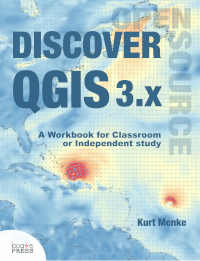
|
2019 | Kurt Menke | Discover QGIS 3.x - A Workbook for Classroom or Independent Study, Locate Press, 406 p., ISBN 978-0998547763 ([6] Locate Press site) |

|
2013 | S. Iacovella and B. Youngblood | GeoServer Beginner's Guide, Packt Publishing, 350 p., ISBN 978-1-84951-668-6 (Packt site) |
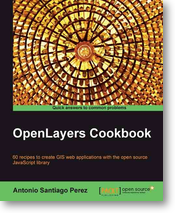
|
2012 | Antonio Santiago | OpenLayers Cookbook, Packt Publishing, 300 p., ISBN 978-1-84951-784-3 ([7]) |
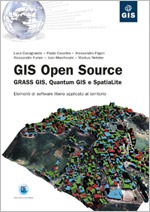
|
2012 | L. Casagrande, P. Cavallini, A. Frigeri, A. Furieri, I. Marchesini, M. Neteler | GIS Open Source: GRASS GIS, Quantum GIS e SpatiaLite. 224p., ISBN 978-8-85790-149-7 (http://tinyurl.com/Libro-GIS-Open-Source, and data download) |
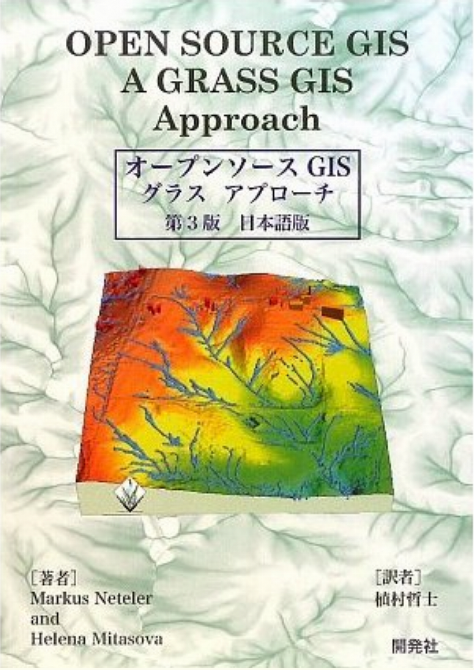
|
2008/2009 | M. Neteler and H. Mitasova - translated by Tetsuji Uemura | オープンソースGISグラスアプローチ (Open Source GIS: A GRASS GIS Approach - in Japanese). 3rd Ed., http://www.grassbook.org - Order |

|
2008 | Bivand, Roger S., Pebesma, Edzer J., Gómez-Rubio, Virgilio | Applied Spatial Data Analysis with R. Series: Use R, 378 p., Softcover, ISBN 978-0-387-78170-9 (Springer Site, Book's Homepage) |
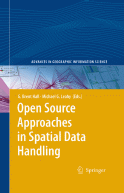
|
2008 | Hall, G. Brent; Leahy, Michael G. (Eds.) | Open Source Approaches in Spatial Data Handling. Series: Advances in Geographic Information Science, 278 p. 126 illus., 29 in color., Hardcover, ISBN 978-3-540-74830-4 (TOC) |
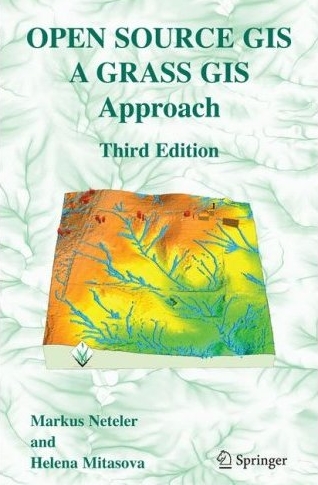
|
2008 | M. Neteler and H. Mitasova | Open Source GIS: A GRASS GIS Approach. 3rd Ed., Springer, New York. 406 pages, ISBN 038735767X, http://www.grassbook.org |
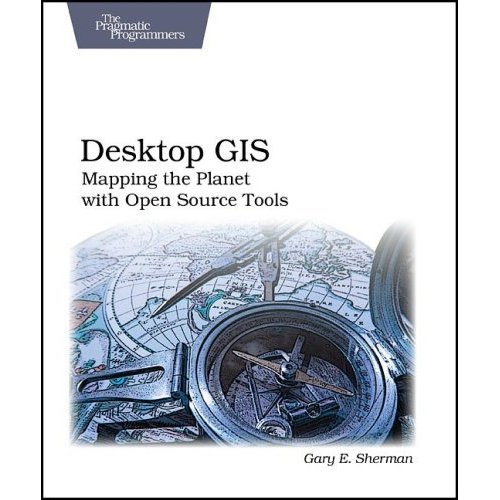
|
2008 | G. Sherman | Desktop GIS: Mapping the Planet with Open Source. Pragmatic Bookshelf, 360 pages, ISBN 1934356069, http://www.pragprog.com/titles/gsdgis/desktop-gis |
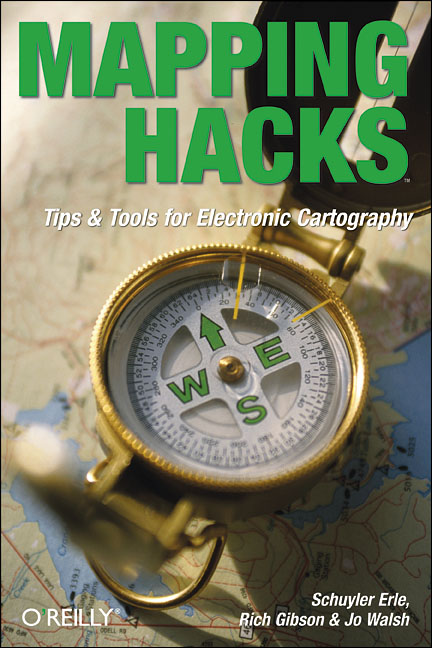
|
2005 | S. Erle, R. Gibson, and J. Walsh, | Mapping Hacks. O'Reilly Media, Inc., 564 pages, ISBN 0596007035, http://mappinghacks.com |
| 2006 | S. Erle and R. Gibson | Google Maps Hacks. O'Reilly Media, Inc., 366 pages, ISBN 0-596-10161-9, http://www.oreilly.com/catalog/googlemapshks/ | |
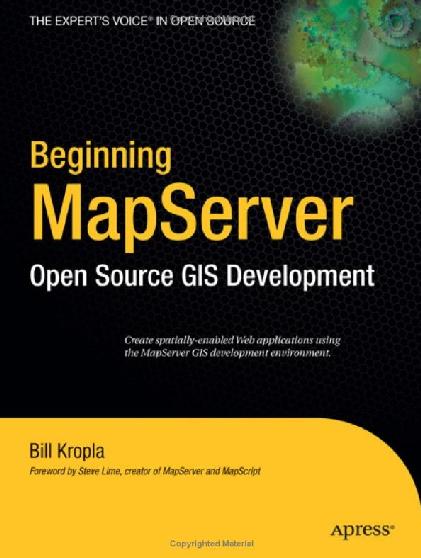
|
2005 | B. Kropla, | Beginning MapServer: Open Source GIS Development (Expert's Voice in Open Source). Apress, 448 pages, ISBN 1590594908, http://www.apress.com/book/bookDisplay.html?bID=443 |
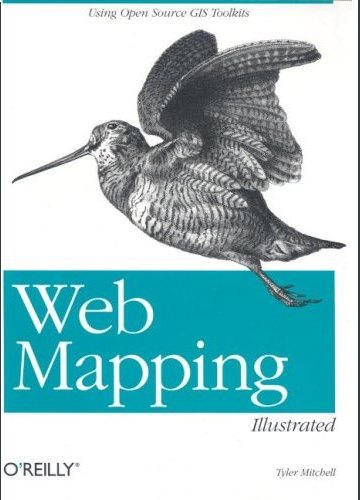
|
2005 | T. Mitchell | Web Mapping Illustrated: Using Open Source GIS Toolkits. O'Reilly Media, Inc., 367 pages, ISBN 0596008651, http://www.oreilly.com/catalog/webmapping/ . Reprints of English version are pending, fall 2008, and may appear out of print at the moment. |
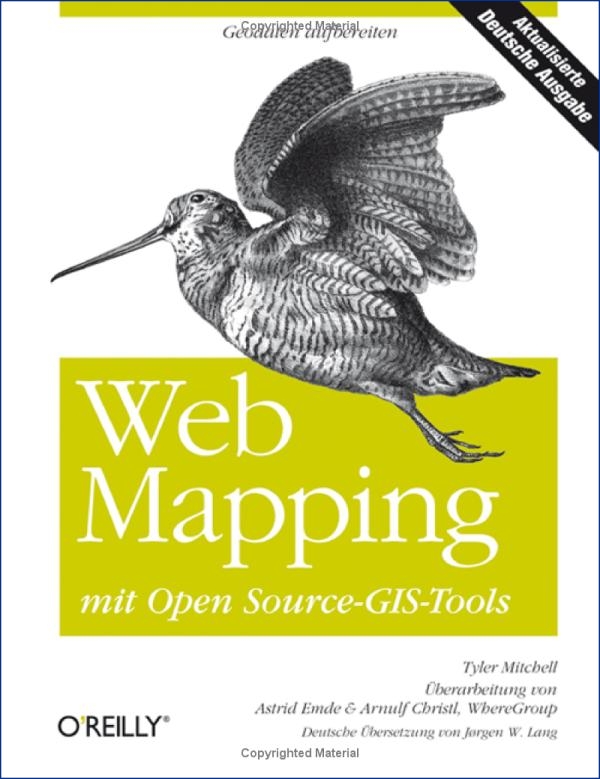
|
2008 | T. Mitchell | Web Mapping Illustrated: Using Open Source GIS Toolkits. O'Reilly Media, Inc., Also available in Japanese and German. |